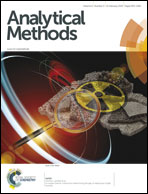Extraction of natural estrogens in environmental waters by dispersive multiwalled carbon nanotube-based agitation-assisted adsorption and ultrasound-assisted desorption
Abstract
A dispersive multiwalled carbon nanotube (MWCNT) based agitation-assisted adsorption and ultrasound-assisted desorption method has been developed for extracting natural estrogenic steroids in environmental waters prior to high performance liquid chromatography-diode array detection (HPLC-DAD) analysis. With the aid of agitation, the trace estrogens in bulk aqueous solution were adsorbed onto milligrams of dispersive MWCNTs. After filtration, the estrogens enriched on MWCNT nanoparticles were quickly desorbed into milliliters of organic solvent in an ultrasonic bath. Finally, the analytes in the organic solvent were directly determined by HPLC-DAD. The stability examination of estrogens under the tested ultrasonic irradiation was performed and the results indicated that the estrogens were stable during the extraction process. Several parameters that could influence the extraction efficiency, such as type and volume of desorption solvent, consumed amount of MWCNTs, pH and ionic strength of sample solution, agitation-assisted adsorption and ultrasound-assisted desorption time, were examined. Under the optimized conditions, the recoveries for three analytes in spiked samples were over 82%. The detection limits were 0.076 ng mL−1 for estrone, 0.049 ng mL−1 for 17β-estradiol, and 0.057 ng mL−1 for estriol, respectively, while the relative standard deviations were less than 9% (at the 20 ng mL−1 estrogen level for 10 runs).


 Please wait while we load your content...
Please wait while we load your content...